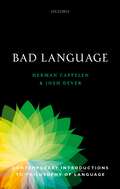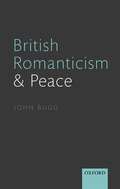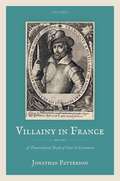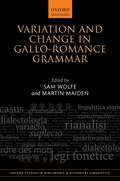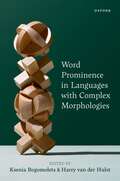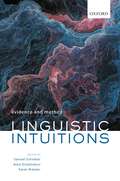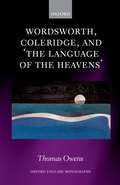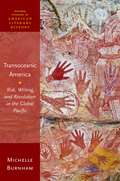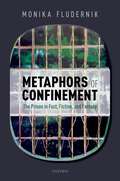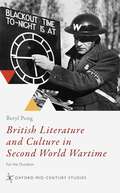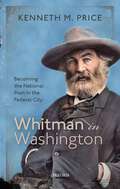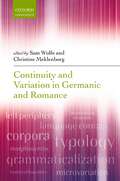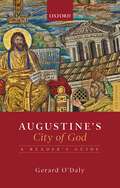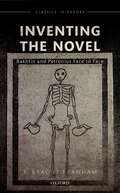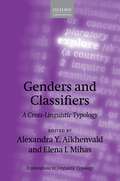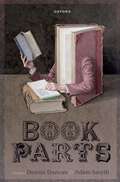- Table View
- List View
Bad Language (Contemporary Introductions to Philosophy of Language)
by Herman Cappelen Josh DeverWhen theorizing about language, we tend to assume that speakers are cooperative, honest, helpful, and so on. This, of course, isn't remotely true of a lot of real-world language use. Bad Language is the first textbook to explore non-idealized language use, the linguistic behaviour of those who exploit language for malign purposes. Two eminent philosophers of language present a lively and accessible introduction to a wide range of topics including lies and bullshit, slurs and insults, coercion and silencing: Cappelen and Dever offer theoretical frameworks for thinking about these all too common linguistic behaviours. As the text does not assume prior training in philosophy or linguistics, it is ideal for use as part of a philosophy of language course for philosophy students or for linguistics students. Bad Language belongs to the series Contemporary Introductions to Philosophy of Language, in which each book introduces an important area of the philosophy of language, suitable for students at any level.
British Romanticism and Peace
by John BuggThis is the first book to bring perspectives from the interdisciplinary field of Peace Studies to bear on the writing of the Romantic period. Particularly significant is that field's attention not only to the work of anti-war protest, but more purposefully to considerations of how peace can actively be fostered, established, and sustained. Bravely resisting discourses of military propaganda, writers such as Amelia Opie, Helen Maria Williams, William Wordsworth, William Cobbett, John Keats, and Jane Austen embarked on the challenging and urgent rhetorical work of imagining—and inspiring others to imagine—the possibility of peace. The writers formulate a peace imaginary in various registers. Sometimes this means identifying and eschewing traditional militaristic tropes in order to craft alternative images for a patriotism compatible with peace. Other times it means turning away from xenophobic discourse to write about relations with other nations in terms other than those of conflict. If historically informed literary criticism has illustrated the importance of writing about war during the Romantic period, this volume invites readers to redirect critical attention to move beyond discourses of war, and to recognize the era's complex and vibrant writing about and for peace.
British Romanticism and Peace
by John BuggThis is the first book to bring perspectives from the interdisciplinary field of Peace Studies to bear on the writing of the Romantic period. Particularly significant is that field's attention not only to the work of anti-war protest, but more purposefully to considerations of how peace can actively be fostered, established, and sustained. Bravely resisting discourses of military propaganda, writers such as Amelia Opie, Helen Maria Williams, William Wordsworth, William Cobbett, John Keats, and Jane Austen embarked on the challenging and urgent rhetorical work of imagining—and inspiring others to imagine—the possibility of peace. The writers formulate a peace imaginary in various registers. Sometimes this means identifying and eschewing traditional militaristic tropes in order to craft alternative images for a patriotism compatible with peace. Other times it means turning away from xenophobic discourse to write about relations with other nations in terms other than those of conflict. If historically informed literary criticism has illustrated the importance of writing about war during the Romantic period, this volume invites readers to redirect critical attention to move beyond discourses of war, and to recognize the era's complex and vibrant writing about and for peace.
Villainy in France (1463-1610): A Transcultural Study of Law and Literature
by Jonathan PattersonObscene poetry, servants' slanders against their masters, the diabolical acts of those who committed massacre and regicide. This is a book about the harmful, outward manifestation of inner malice—villainy—in French culture (1463-1610). In pre-modern France, villainous offences were countered, if never fully contained, by intersecting legal and literary responses. Combining the methods of legal anthropology with literary and historical analysis, this study examines villainy across juridical documents, criminal records, and literary texts. Whilst few people obtained justice through the law, many pursued out-of-court settlements of one kind or another. Literary texts commemorated villainies both fictitious and historical; literature sometimes instantiated the process of redress, and enabled the transmission of conflicts from one context to another. Villainy in France follows this overflowing current of pre-modern French culture, examining its impact within France and across the English Channel. Scholars and cultural critics of the Anglophone world have long been fascinated by villainy and villains. This book reveals the subject's significant 'Frenchness' and establishes a transcultural approach to it in law and literature. In this study, villainy's particular significance emerges through its representation in authors remembered for their less-than respectable, even criminal, activities: François Villon, Clément Marot, François Rabelais, Pierre de L'Estoile, Christopher Marlowe, Ben Jonson, John Marston, and George Chapman. Villainy in France affords legal-literary comparison of these authors alongside many of their lesser-known contemporaries; in so doing, it reinterprets French conflicts within a wider European context, from the mid-fifteenth century to the early seventeenth century.
Villainy in France (1463-1610): A Transcultural Study of Law and Literature
by Jonathan PattersonObscene poetry, servants' slanders against their masters, the diabolical acts of those who committed massacre and regicide. This is a book about the harmful, outward manifestation of inner malice—villainy—in French culture (1463-1610). In pre-modern France, villainous offences were countered, if never fully contained, by intersecting legal and literary responses. Combining the methods of legal anthropology with literary and historical analysis, this study examines villainy across juridical documents, criminal records, and literary texts. Whilst few people obtained justice through the law, many pursued out-of-court settlements of one kind or another. Literary texts commemorated villainies both fictitious and historical; literature sometimes instantiated the process of redress, and enabled the transmission of conflicts from one context to another. Villainy in France follows this overflowing current of pre-modern French culture, examining its impact within France and across the English Channel. Scholars and cultural critics of the Anglophone world have long been fascinated by villainy and villains. This book reveals the subject's significant 'Frenchness' and establishes a transcultural approach to it in law and literature. In this study, villainy's particular significance emerges through its representation in authors remembered for their less-than respectable, even criminal, activities: François Villon, Clément Marot, François Rabelais, Pierre de L'Estoile, Christopher Marlowe, Ben Jonson, John Marston, and George Chapman. Villainy in France affords legal-literary comparison of these authors alongside many of their lesser-known contemporaries; in so doing, it reinterprets French conflicts within a wider European context, from the mid-fifteenth century to the early seventeenth century.
Variation and Change in Gallo-Romance Grammar (Oxford Studies in Diachronic and Historical Linguistics #41)
This volume offers a wide-range of case studies on variation and change in the sub-family of the Romance languages that includes French and Occitan: Gallo-Romance. Both standard and non-standard Gallo-Romance data can be of enormous value to studies of morphosyntactic variation and change, yet, as the volume demonstrates, non-standard and comparative Gallo-Romance data have often been lacking in both synchronic and diachronic studies. Following an introduction that sets out the conceptual background, the volume is divided into three parts whose chapters explore a variety of topics in the domains of sentence structure, the verb complex, and word structure. The empirical foundation of the volume is exceptionally rich, drawing on standard and non-standard data from French, Occitan, Francoprovençal, Picard, Wallon, and Norman. This diversity is also reflected in the theoretical and conceptual approaches adopted, which span traditional philology, sociolinguistics, formal morphological and syntactic theory, semantics, and discourse-pragmatics. The volume will thus be an indispensable tool for researchers and students in French and (Gallo-) Romance linguistics as well as for readers interested in grammatical theory, sociolinguistics, and historical linguistics.
Word Prominence in Languages with Complex Morphologies
This volume focuses on the theoretical and analytical challenges that languages with complex morphologies pose for the theory and typology of word-level prosodic phenomena. The morphological complexity and phonological length that are characteristic of words in these languages make them a particularly fruitful ground for investigating the effects of both phonological and morphological factors in the assignment of prominence. The first three chapters in the volume explore general theoretical issues pertaining to word prominence in synthetic languages, including the issue of 'wordhood' and the empirical, theoretical, and methodological issues with delineating word-level prominence and the higher-level prosodic phenomena in these languages. These are followed by a series of case studies on stress, accent, and tone in a geographically and genetically diverse set of languages with highly synthetic morphologies including languages of the Americas, Europe and Asia, and Australia. The volume adopts an interdisciplinary perspective, combining phonetic, phonological, and morphosyntactic insights. It will be of interest not only to phonologists and morphologists, but to all those interested in the typological and theoretical issues relating to polysynthetic languages.
Linguistic Intuitions: Evidence and Method
This book examines the evidential status and use of linguistic intuitions, a topic that has seen increased interest in recent years. Linguists use native speakers' intuitions - such as whether or not an utterance sounds acceptable - as evidence for theories about language, but this approach is not uncontroversial. The two parts of this volume draw on the most recent work in both philosophy and linguistics to explore the two major issues at the heart of the debate. Chapters in the first part address the 'justification question', critically analysing and evaluating the theoretical rationale for the evidential use of linguistic intuitions. The second part discusses recent developments in the domain of experimental syntax, focusing on the question of whether gathering intuitions experimentally is epistemically and methodologically superior to the informal methods that have traditionally been used. The volume provides valuable insights into whether and how linguistic intuitions can be used in theorizing about language, and will be of interest to graduate students and researchers in linguistics, philosophy, and cognitive science.
Wordsworth, Coleridge, and 'the language of the heavens' (Oxford English Monographs)
by Thomas OwensThomas Owens explores some of the exultant visions inspired by Wordsworth's and Coleridge's close scrutiny of the night sky, the natural world, and the domains of science. He examines a set of scientific patterns drawn from natural, geometric, celestial, and astronomical sources which Wordsworth and Coleridge used to express their ideas about poetry, religion, literary criticism, and philosophy, and establishes the central importance of analogy in their creative thinking. Analogies prompted the poets' imaginings in geometry and cartography, in nature (representations of the moon) and natural history (studies of spider-webs, streams, and dew), in calculus and conical refraction, and in the discovery of infra-red and ultraviolet light. Although this is primarily a study of the patterns which inspired their writing, the findings overturn the prevalent critical consensus that Wordsworth and Coleridge did not have the access, interest, or capacity to understand the latest developments in nineteenth-century astronomy and mathematics, which they did in fact possess. Wordsworth, Coleridge, and 'the language of the heavens' reinstates many relationships which the poets had with scientists and their sources. Most significantly, the book illustrates that these sources are not simply another context or historical lens through which to engage with Wordsworth's and Coleridge's work but are instead a controlling device of the symbolic imagination. Exploring the structures behind Wordsworth's and Coleridge's poems and metaphysics stakes out a return to the evidence of the Romantic imagination, not for its own sake, but in order to reveal that their analogical configuration of the world provided them with a scaffold for thinking, an intellectual orrery which ordered artistic consciousness and which they never abandoned.
Wordsworth, Coleridge, and 'the language of the heavens' (Oxford English Monographs)
by Thomas OwensThomas Owens explores some of the exultant visions inspired by Wordsworth's and Coleridge's close scrutiny of the night sky, the natural world, and the domains of science. He examines a set of scientific patterns drawn from natural, geometric, celestial, and astronomical sources which Wordsworth and Coleridge used to express their ideas about poetry, religion, literary criticism, and philosophy, and establishes the central importance of analogy in their creative thinking. Analogies prompted the poets' imaginings in geometry and cartography, in nature (representations of the moon) and natural history (studies of spider-webs, streams, and dew), in calculus and conical refraction, and in the discovery of infra-red and ultraviolet light. Although this is primarily a study of the patterns which inspired their writing, the findings overturn the prevalent critical consensus that Wordsworth and Coleridge did not have the access, interest, or capacity to understand the latest developments in nineteenth-century astronomy and mathematics, which they did in fact possess. Wordsworth, Coleridge, and 'the language of the heavens' reinstates many relationships which the poets had with scientists and their sources. Most significantly, the book illustrates that these sources are not simply another context or historical lens through which to engage with Wordsworth's and Coleridge's work but are instead a controlling device of the symbolic imagination. Exploring the structures behind Wordsworth's and Coleridge's poems and metaphysics stakes out a return to the evidence of the Romantic imagination, not for its own sake, but in order to reveal that their analogical configuration of the world provided them with a scaffold for thinking, an intellectual orrery which ordered artistic consciousness and which they never abandoned.
Transoceanic America: Risk, Writing, and Revolution in the Global Pacific (Oxford Studies in American Literary History)
by Michelle BurnhamTransoceanic America offers a new approach to American literature by emphasizing the material and conceptual interconnectedness of the Atlantic and Pacific worlds. These oceans were tied together economically, textually, and politically, through such genres as maritime travel writing, mathematical and navigational schoolbooks, and the relatively new genre of the novel. Especially during the age of revolutions in the late eighteenth and early nineteenth centuries, long-distance transoceanic travel required calculating and managing risk in the interest of profit. The result was the emergence of a newly suspenseful form of narrative that came to characterize capitalist investment, political revolution, and novelistic plot. The calculus of risk that drove this expectationist narrative also concealed violence against vulnerable bodies on ships and shorelines around the world. A transoceanic American literary and cultural history requires new non-linear narratives to tell the story of this global context and to recognize its often forgotten textual archive.
Transoceanic America: Risk, Writing, and Revolution in the Global Pacific (Oxford Studies in American Literary History)
by Michelle BurnhamTransoceanic America offers a new approach to American literature by emphasizing the material and conceptual interconnectedness of the Atlantic and Pacific worlds. These oceans were tied together economically, textually, and politically, through such genres as maritime travel writing, mathematical and navigational schoolbooks, and the relatively new genre of the novel. Especially during the age of revolutions in the late eighteenth and early nineteenth centuries, long-distance transoceanic travel required calculating and managing risk in the interest of profit. The result was the emergence of a newly suspenseful form of narrative that came to characterize capitalist investment, political revolution, and novelistic plot. The calculus of risk that drove this expectationist narrative also concealed violence against vulnerable bodies on ships and shorelines around the world. A transoceanic American literary and cultural history requires new non-linear narratives to tell the story of this global context and to recognize its often forgotten textual archive.
Metaphors of Confinement: The Prison in Fact, Fiction, and Fantasy (Law and Literature)
by Monika FludernikMetaphors of Confinement: The Prison in Fact, Fiction, and Fantasy offers a historical survey of imaginings of the prison as expressed in carceral metaphors in a range of texts about imprisonment from Antiquity to the present as well as non-penal situations described as confining or restrictive. These imaginings coalesce into a 'carceral imaginary' that determines the way we think about prisons, just as social debates about punishment and criminals feed into the way carceral imaginary develops over time. Examining not only English-language prose fiction but also poetry and drama from the Middle Ages to postcolonial, particularly African, literature, the book juxtaposes literary and non-literary contexts and contrasts fictional and nonfictional representations of (im)prison(ment) and discussions about the prison as institution and experiential reality. It comments on present-day trends of punitivity and foregrounds the ethical dimensions of penal punishment. The main argument concerns the continuity of carceral metaphors through the centuries despite historical developments that included major shifts in policy (such as the invention of the penitentiary). The study looks at selected carceral metaphors, often from two complementary perspectives, such as the home as prison or the prison as home, or the factory as prison and the prison as factory. The case studies present particularly relevant genres and texts that employ these metaphors, often from a historical perspective that analyses development through different periods.
Metaphors of Confinement: The Prison in Fact, Fiction, and Fantasy (Law and Literature)
by Monika FludernikMetaphors of Confinement: The Prison in Fact, Fiction, and Fantasy offers a historical survey of imaginings of the prison as expressed in carceral metaphors in a range of texts about imprisonment from Antiquity to the present as well as non-penal situations described as confining or restrictive. These imaginings coalesce into a 'carceral imaginary' that determines the way we think about prisons, just as social debates about punishment and criminals feed into the way carceral imaginary develops over time. Examining not only English-language prose fiction but also poetry and drama from the Middle Ages to postcolonial, particularly African, literature, the book juxtaposes literary and non-literary contexts and contrasts fictional and nonfictional representations of (im)prison(ment) and discussions about the prison as institution and experiential reality. It comments on present-day trends of punitivity and foregrounds the ethical dimensions of penal punishment. The main argument concerns the continuity of carceral metaphors through the centuries despite historical developments that included major shifts in policy (such as the invention of the penitentiary). The study looks at selected carceral metaphors, often from two complementary perspectives, such as the home as prison or the prison as home, or the factory as prison and the prison as factory. The case studies present particularly relevant genres and texts that employ these metaphors, often from a historical perspective that analyses development through different periods.
British Literature and Culture in Second World Wartime: For the Duration (Oxford Mid-Century Studies Series)
by Beryl PongBritish Literature and Culture in Second World Wartime excavates British late modernism's relationship to war in terms of chronophobia: a joint fear of the past and future. As a wartime between, but distinct from, those of the First World War and the Cold War, Second World wartime involves an anxiety that is both repetition and imaginary: both a dread of past violence unleashed anew, and that of a future violence still ungraspable. Identifying a constellation of temporalities and affects under three tropes—time capsules, time zones, and ruins—this volume contends that Second World wartime is a pivotal moment when wartime surpassed the boundaries of a specific state of emergency, becoming first routine and then open-ended. It offers a synoptic, wide-ranging look at writers on the home front, including Henry Green, Elizabeth Bowen, Virginia Woolf, and Rose Macaulay, through a variety of genres, such as life-writing, the novel, and the short story. It also considers an array of cultural and archival material from photographers such as Cecil Beaton, filmmakers such as Charles Crichton, and artists such as John Minton. It shows how figures harnessed or exploited their media's temporal properties to formally register the distinctiveness of this wartime through a complex feedback between anticipation and retrospection, oftentimes fashioning the war as a memory, even while it was taking place. While offering a strong foundation for new readers of the mid-century, the book's overall theoretical focus on chronophobia will be an important intervention for those already working in the field.
British Literature and Culture in Second World Wartime: For the Duration (Oxford Mid-Century Studies Series)
by Beryl PongBritish Literature and Culture in Second World Wartime excavates British late modernism's relationship to war in terms of chronophobia: a joint fear of the past and future. As a wartime between, but distinct from, those of the First World War and the Cold War, Second World wartime involves an anxiety that is both repetition and imaginary: both a dread of past violence unleashed anew, and that of a future violence still ungraspable. Identifying a constellation of temporalities and affects under three tropes—time capsules, time zones, and ruins—this volume contends that Second World wartime is a pivotal moment when wartime surpassed the boundaries of a specific state of emergency, becoming first routine and then open-ended. It offers a synoptic, wide-ranging look at writers on the home front, including Henry Green, Elizabeth Bowen, Virginia Woolf, and Rose Macaulay, through a variety of genres, such as life-writing, the novel, and the short story. It also considers an array of cultural and archival material from photographers such as Cecil Beaton, filmmakers such as Charles Crichton, and artists such as John Minton. It shows how figures harnessed or exploited their media's temporal properties to formally register the distinctiveness of this wartime through a complex feedback between anticipation and retrospection, oftentimes fashioning the war as a memory, even while it was taking place. While offering a strong foundation for new readers of the mid-century, the book's overall theoretical focus on chronophobia will be an important intervention for those already working in the field.
Whitman in Washington: Becoming the National Poet in the Federal City
by Kenneth M. PriceDuring Walt Whitman's decade in Washington, DC, 1863-1873, he labored intensely, at times seeming to have three lives at once. He wrote the most distinguished journalism of his career; came into his own as a writer of letters; crafted memorable Civil War poetry, Drum-Taps and Sequel to Drum-Taps and later folded it into heavily revised and expanded versions of Leaves of Grass; and produced his searching but also flawed critique of American culture, Democratic Vistas. Whitman's work through the first three editions of Leaves often receives the highest praise, yet his writing in the Washington years is exceptional, too, by any reckoning—and is all the more remarkable given that he also cared for thousands of wounded and sick soldiers in Washington hospitals, serving as an attentive visitor. In addition, he served as a government clerk in various positions, most notably in the attorney general's office when much was accomplished on the road toward a multi-racial democracy including efforts to suppress the Ku Klux Klan, and much was also missed (both by the attorney general's office and by Whitman) in the efforts to advance a more just and vibrant union. This book analyses Whitman's integrated life, writings, and government work in his urban context to re-evaluate the writer and the nation's capital in a time of transformation. Drawing on an expanded Whitman corpus, including nearly 3,000 Whitman documents the author recently identified in the National Archives, Whitman in Washington demonstrates that the power of Whitman's Civil War and Reconstruction writing emerges, more fully than we could ever before have imagined, from his intimate knowledge of the capital city, its bureaucracies, and its tumultuous post-war history.
Whitman in Washington: Becoming the National Poet in the Federal City
by Kenneth M. PriceDuring Walt Whitman's decade in Washington, DC, 1863-1873, he labored intensely, at times seeming to have three lives at once. He wrote the most distinguished journalism of his career; came into his own as a writer of letters; crafted memorable Civil War poetry, Drum-Taps and Sequel to Drum-Taps and later folded it into heavily revised and expanded versions of Leaves of Grass; and produced his searching but also flawed critique of American culture, Democratic Vistas. Whitman's work through the first three editions of Leaves often receives the highest praise, yet his writing in the Washington years is exceptional, too, by any reckoning—and is all the more remarkable given that he also cared for thousands of wounded and sick soldiers in Washington hospitals, serving as an attentive visitor. In addition, he served as a government clerk in various positions, most notably in the attorney general's office when much was accomplished on the road toward a multi-racial democracy including efforts to suppress the Ku Klux Klan, and much was also missed (both by the attorney general's office and by Whitman) in the efforts to advance a more just and vibrant union. This book analyses Whitman's integrated life, writings, and government work in his urban context to re-evaluate the writer and the nation's capital in a time of transformation. Drawing on an expanded Whitman corpus, including nearly 3,000 Whitman documents the author recently identified in the National Archives, Whitman in Washington demonstrates that the power of Whitman's Civil War and Reconstruction writing emerges, more fully than we could ever before have imagined, from his intimate knowledge of the capital city, its bureaucracies, and its tumultuous post-war history.
Continuity and Variation in Germanic and Romance
This volume offers a range of synchronic and diachronic case studies in comparative Germanic and Romance morphosyntax. These two language families, spoken by over a billion people today, have played a central role in linguistic research, but many significant questions remain about the relationship between them. Following an introduction that sets out the methodological, empirical, and theoretical background to the book, the volume is divided into three parts that deal with the morphosyntax of subjects and the inflectional layer; inversion, discourse pragmatics, and the left periphery; and continuity and variation beyond the clause. The contributors adopt a diverse range of approaches, making use of the latest digitized corpora and presenting a mixture of well-known and under-studied data from standard and non-standard Germanic and Romance languages. Many of the chapters challenge received wisdom about the relationship between these two important language families. The volume will be an indispensable resource for researchers and students in the fields of Germanic and Romance linguistics, historical and comparative linguistics, and morphosyntax.
Augustine's City of God: A Reader's Guide
by Gerard O'DalyThe most influential of Augustine's works, City of God played a decisive role in the formation of the Christian West. Augustine wrote City of God in the aftermath of the Gothic sack of Rome in AD 410, at a time of rapid Christianization across the Roman Empire. Gerard O'Daly's book remains the most comprehensive modern guide in any language to this seminal work of European literature. In this new and extensively revised edition, O'Daly takes into account the abundant scholarship on Augustine in the twenty years since its first publication, while retaining the book's focus on Augustine as a writer in the Latin tradition. He explores the many themes of City of God, which include cosmology, political thought, anti-pagan polemic, Christian apologetic, theory of history, and biblical interpretation. This guide, therefore, is about a single literary masterpiece, yet at the same time it surveys Augustine's developing views through the whole range of his thought. As well as a running commentary on each part of the work, O'Daly provides chapters on the themes of the work, a bibliographical guide to research on its reception, translations of any Greek and Latin texts discussed, and detailed suggestions for further reading.
Augustine's City of God: A Reader's Guide
by Gerard O'DalyThe most influential of Augustine's works, City of God played a decisive role in the formation of the Christian West. Augustine wrote City of God in the aftermath of the Gothic sack of Rome in AD 410, at a time of rapid Christianization across the Roman Empire. Gerard O'Daly's book remains the most comprehensive modern guide in any language to this seminal work of European literature. In this new and extensively revised edition, O'Daly takes into account the abundant scholarship on Augustine in the twenty years since its first publication, while retaining the book's focus on Augustine as a writer in the Latin tradition. He explores the many themes of City of God, which include cosmology, political thought, anti-pagan polemic, Christian apologetic, theory of history, and biblical interpretation. This guide, therefore, is about a single literary masterpiece, yet at the same time it surveys Augustine's developing views through the whole range of his thought. As well as a running commentary on each part of the work, O'Daly provides chapters on the themes of the work, a bibliographical guide to research on its reception, translations of any Greek and Latin texts discussed, and detailed suggestions for further reading.
Inventing the Novel: Bakhtin and Petronius Face to Face (Classics in Theory Series)
by R. Bracht BranhamInventing the Novel uses the work of the Russian philosopher Mikhail Bakhtin (1895-1975) to explore the ancient origins of the modern novel. The analysis focuses on one of the most elusive works of classical antiquity, the Satyrica, written by Nero's courtier, Petronius Arbiter (whose singular suicide, described by Tacitus, is as famous as his novel). Petronius was the most lauded ancient novelist of the twentieth century and the Satyrica served as the original model for F. Scott Fitzgerald's The Great Gatsby (1925), as well as providing the epigraph for T. S. Eliot's The Waste Land (1922), and the basis for Fellini Satyricon (1969). Bakhtin's work on the novel was deeply informed by his philosophical views: if, as a phenomenologist, he is a philosopher of consciousness, as a student of the novel, he is a philosopher of the history of consciousness, and it is the role of the novel in this history that held his attention. This volume seeks to lay out an argument in four parts that supports Bakhtin's sweeping assertion that the Satyrica plays an "immense" role in the history of the novel, beginning in Chapter 1 with his equally striking claim that the novel originates as a new way of representing time and proceeding to the question of polyphony in Petronius and the ancient novel.
Inventing the Novel: Bakhtin and Petronius Face to Face (Classics in Theory Series)
by R. Bracht BranhamInventing the Novel uses the work of the Russian philosopher Mikhail Bakhtin (1895-1975) to explore the ancient origins of the modern novel. The analysis focuses on one of the most elusive works of classical antiquity, the Satyrica, written by Nero's courtier, Petronius Arbiter (whose singular suicide, described by Tacitus, is as famous as his novel). Petronius was the most lauded ancient novelist of the twentieth century and the Satyrica served as the original model for F. Scott Fitzgerald's The Great Gatsby (1925), as well as providing the epigraph for T. S. Eliot's The Waste Land (1922), and the basis for Fellini Satyricon (1969). Bakhtin's work on the novel was deeply informed by his philosophical views: if, as a phenomenologist, he is a philosopher of consciousness, as a student of the novel, he is a philosopher of the history of consciousness, and it is the role of the novel in this history that held his attention. This volume seeks to lay out an argument in four parts that supports Bakhtin's sweeping assertion that the Satyrica plays an "immense" role in the history of the novel, beginning in Chapter 1 with his equally striking claim that the novel originates as a new way of representing time and proceeding to the question of polyphony in Petronius and the ancient novel.
Genders and Classifiers: A Cross-Linguistic Typology (Explorations in Linguistic Typology)
This volume offers a comprehensive account of the typology of noun classification across the world's languages. Every language has some means of categorizing objects into humans, or animates, or by their shape, form, size, and function. The most widespread are linguistic genders - grammatical classes of nouns based on core semantic properties such as sex (female and male), animacy, humanness, and also shape and size. Classifiers of several types also serve to categorize entities. Numeral classifiers occur with number words, possessive classifiers appear in the expressions of possession, and verbal classifiers are used on a verb, categorizing its argument. These varied sorts of genders and classifiers can also occur together. This volume elaborates on the expression, usage, history, and meanings of noun categorization devices, exploring their various facets across the languages of South America and Asia, which are known for the diversity of their noun categorization. The volume begins with a typological introduction that outlines the types of noun categorization devices and their expression, scope, functions, and development, as well as sociocultural aspects of their use. The following nine chapters provide in-depth studies of genders and classifiers of different types in a range of South American and Asian languages and language families, including Arawak languages, Zamucoan, Hmong, and Japanese.
Book Parts
What would an anatomy of the book look like? There is the main text, of course, the file that the author proudly submits to their publisher. But around this, hemming it in on the page or enclosing it at the front and back of the book, there are dozens of other texts—page numbers and running heads, copyright statements and errata lists—each possessed of particular conventions, each with their own lively histories. To consider these paratexts—recalling them from the margins, letting them take centre stage—is to be reminded that no book is the sole work of the author whose name appears on the cover; rather, every book is the sum of a series of collaborations. It is to be reminded, also, that not everything is intended for us, the readers. There are sections that are solely directed at others—binders, librarians, lawyers—parts of the book that, if they are working well, are working discreetly, like a theatrical prompt, whispering out of the audience's ear-shot Book Parts is a bold and imaginative intervention in the fast growing field of book history: it pulls the book apart. Over twenty-two chapters, Book Parts tells the story of the components of the book: from title pages to endleaves; from dust jackets to indexes—and just about everything in between. Book Parts covers a broad historical range that runs from the pre-print era to the digital, bringing together the expertise of some of the most exciting scholars working on book history today in order to shine a new light on these elements hiding in plain sight in the books we all read.
